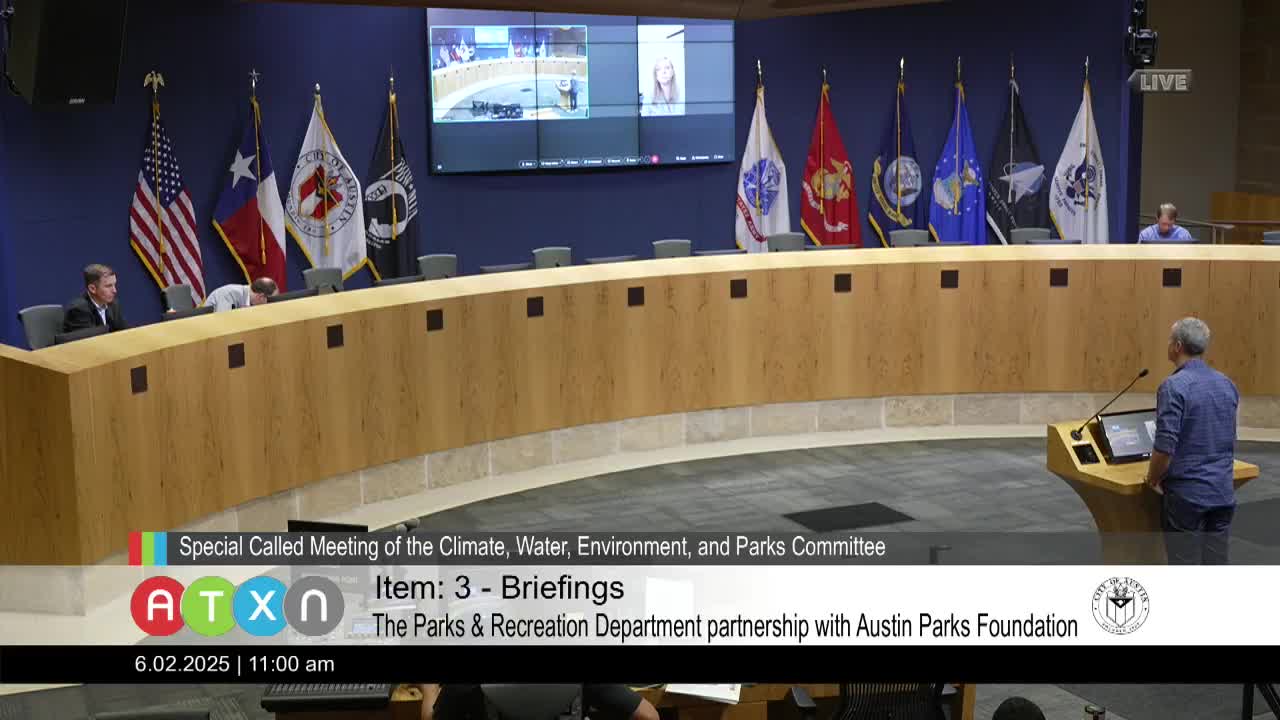Parks Department prioritizes community feedback in project funding and maintenance strategies
June 02, 2025 | Austin, Travis County, Texas
This article was created by AI summarizing key points discussed. AI makes mistakes, so for full details and context, please refer to the video of the full meeting. Please report any errors so we can fix them. Report an error »

In a recent special meeting of the Austin Climate, Water, Environment, and Parks Committee, city officials discussed the ongoing challenges and future plans for Austin's parks and recreational facilities. The atmosphere was charged with a sense of urgency as committee members sought to address the pressing needs of the community while navigating the complexities of funding and project timelines.
One of the key highlights was the anticipated launch of a new online dashboard designed to enhance transparency regarding park projects and funding sources. This tool aims to allow residents to easily access information about local mobility programs and parkland dedication fees, fostering a deeper connection between the community and its public spaces. Committee members expressed enthusiasm about this initiative, emphasizing its potential to showcase successful partnerships and engage residents in the development of their neighborhoods.
However, the conversation quickly turned to the realities of project timelines, with officials acknowledging that while three years is an ambitious target for completing park projects, many factors contribute to delays. The complexity of projects, community input, and funding constraints were cited as significant hurdles. One official humorously noted that the desire for a simple playground can lead to heated debates among community members, illustrating the challenges of managing public land and meeting diverse expectations.
The discussion also highlighted a critical staffing gap within the parks department, with nearly 75 positions unfilled. This shortage has raised concerns about the department's ability to maintain existing facilities while also pursuing new projects. Officials pointed out that Austin spends significantly less on park maintenance per capita compared to other cities, indicating a need for alternative funding strategies. Suggestions included exploring user fees or partnerships with philanthropic organizations to bolster maintenance budgets.
As the meeting progressed, committee members emphasized the importance of prioritizing upgrades in historically underserved neighborhoods, ensuring that all areas of Austin benefit from improved park facilities. The parks department is currently working on a comprehensive study to identify additional funding sources and best practices from other cities, which is expected to be presented to the council in June.
In closing, the committee underscored the need for a collaborative approach to streamline processes and enhance the efficiency of park projects. As Austin continues to grow, the challenge remains to balance the demand for new amenities with the necessity of maintaining existing ones, ensuring that the city's parks can serve as vibrant community spaces for generations to come.
One of the key highlights was the anticipated launch of a new online dashboard designed to enhance transparency regarding park projects and funding sources. This tool aims to allow residents to easily access information about local mobility programs and parkland dedication fees, fostering a deeper connection between the community and its public spaces. Committee members expressed enthusiasm about this initiative, emphasizing its potential to showcase successful partnerships and engage residents in the development of their neighborhoods.
However, the conversation quickly turned to the realities of project timelines, with officials acknowledging that while three years is an ambitious target for completing park projects, many factors contribute to delays. The complexity of projects, community input, and funding constraints were cited as significant hurdles. One official humorously noted that the desire for a simple playground can lead to heated debates among community members, illustrating the challenges of managing public land and meeting diverse expectations.
The discussion also highlighted a critical staffing gap within the parks department, with nearly 75 positions unfilled. This shortage has raised concerns about the department's ability to maintain existing facilities while also pursuing new projects. Officials pointed out that Austin spends significantly less on park maintenance per capita compared to other cities, indicating a need for alternative funding strategies. Suggestions included exploring user fees or partnerships with philanthropic organizations to bolster maintenance budgets.
As the meeting progressed, committee members emphasized the importance of prioritizing upgrades in historically underserved neighborhoods, ensuring that all areas of Austin benefit from improved park facilities. The parks department is currently working on a comprehensive study to identify additional funding sources and best practices from other cities, which is expected to be presented to the council in June.
In closing, the committee underscored the need for a collaborative approach to streamline processes and enhance the efficiency of park projects. As Austin continues to grow, the challenge remains to balance the demand for new amenities with the necessity of maintaining existing ones, ensuring that the city's parks can serve as vibrant community spaces for generations to come.
View full meeting
This article is based on a recent meeting—watch the full video and explore the complete transcript for deeper insights into the discussion.
View full meeting
